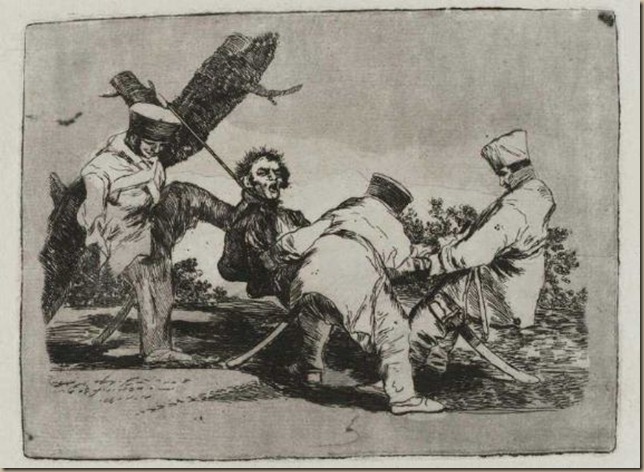While my brief hiatus continues, please enjoy this post from 1/12/2012–in the spirit of Halloween.
One persistent, serious argument against the view that food preparation can be an art is that food preparation, unlike the visual arts, lacks deep meaning and the ability to represent the many dimensions of human life. While paintings can represent and comment on the horrors of war, mine the endless permutations of modern alienation, or subtly expose the character flaws of a fatuous nitwit, food is about only flavor and texture. We learn little about ourselves or the world through food regardless of how well-prepared so the argument goes.
Food writer John Mariani recently gave a version of this argument:
There is ugly art (Hieronymus Bosch) and troubling art (Goya’s Disasters of War) and art that is deliberately in your face (Kerouac’s On the Road), disorienting (Kubrick’s 2001), even repulsive (the Sex Pistols’ “God Save the Queen”). Cooking, on the other hand, should be none of these things except, perhaps, beautiful to look at on the plate and delicious on the tongue. Creative cooking might well enlighten a person to new possibilities or ways of thinking about a pea shoot, and that is a good thing in a world of fast, frozen, chemically-enhanced foods. Cooking can be provocative, but it is the rare chef who makes food that is deliberately distasteful or that seeks to outrage people, as great art often does.
Apparently, Mariani missed the “Wicked Meal” episode of Top Chef, where the challenge was to make “evil” food for the Evil Snow Queen fetchingly played by Charlize Theron. And he must have missed the anthropological accounts of women expressing anger and resentment through the inedible dishes they serve to guests and families. (See “Thick Sauce” by Stoller and Olkes reprinted here). Clearly, chefs and cooks, when they are so inclined, can make food that represents the horrible and ugly. But, nevertheless, Mariani is right that food, in the ordinary contexts in which food is served, must taste good or it will not serve its main functions of nourishment and enjoyment. The food served on Top Chefduring the above referenced episode was tasty despite the grotesque connotations.
However, I think that episode of Top Chef is in fact instructive, not only regarding the nature of food, but the nature of art. The wasted, deformed bodies depicted in Goya’s Disasters of War are indeed grotesque. Yet even the ugly must seduce if it is to be art.
We don’t recoil from viewing these etchings and run screaming from the museum in a fit of rage or fright. We are fascinated by Goya’s extraordinary ability to use line and shadow as a vehicle to highlight atrocity. The spectacle of a artist relishing violence and mayhem is itself seductive and the contrast between the blindness of atrocity and the prurient insight we gain from viewing is part of the seduction. Formally, the rough lines and use of shading focus our attention but the muted colors have a distancing effect on the viewer. The aim is to spark reflection on atrocity but the vaguely cartoonish characters contain a different message—the slaughter bench of history is so pervasive that one in the end can only laugh.
We might react emotionally and empathically to violent visual art but we do so because we view it from a safe distance—where real fear or real revulsion are inappropriate. Our response to the ugly and horrifying is sublime in Edmund Burke’s sense of that term—art puts us at a safe distance so we can reflect, not merely react. Something similar could be said of the Sex Pistols—they use revulsion in order to depict the sterility and nihilism of modern society. But if we felt revulsion toward the Sex Pistols, we simply would not listen. What they represent is repulsive but their means of representation is not, at least for their fans.
Art like food must “taste good” , give us pleasure, if its representation is to succeed. I do not know and do not wish to know anyone whose aesthetic appreciation is of the ugly as such—who gets pleasure not only in viewing what is ugly but reveling in the ugliness of the presentation. That is surely pathological.
Our reaction to food is quite similar to our response to Goya’s painting. There is nothing in ordinary life more violent than the act of eating. We rend and tear at our food after it has been slaughtered, butchered and burned to a crisp—and then we swallow and assimilate it to our own substance. Yet we are attracted to the act of eating via the pangs of hunger and the charms of flavor and aroma. All eating represents the horrible and the grotesque. That we fail to attend to it is testimony both to our capacity for self-deception and the talents of chefs who induce us to find pleasure in their presentation.
Food may be limited in what it can depict (although I think its limitations are exaggerated) but it is not mute when it comes to representing the ugly.
My comments on other aspects of Mariani’s argument are here.



One comment